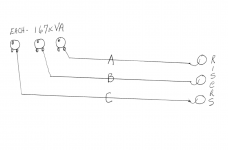The engineered design has three 167kVA oil filled transformers to serve an oilfield load. The secondary voltage is 480/277Y. There are three 4/0 aluminum quadraplex overhead service wire runs between the transformers and the customer's load risers.
SOP has been to pull the A, B&C phases from each service run and connect to the load. Two runs of quadraplex or ten runs, A, B&C is pulled from each run. This can become inconvenient with multiple service runs and can look like a rat's nest on both ends when complete.
A contract crew built this job with the designed transformers and the three runs of 4/0Q service wire.
On this build, each run became a single phase to the load. All three insulated aluminum conductors supported by the ACSR were connected to only one of the three phases. This does look cleaner and was simpler to build.
History shows that if these conductors were in a rigid steel pipe, overheating will occur because no cancelling can take place.
The code does allow one conduit to carry only one phase, but the conduit must be non-ferrous, usually PVC.
The concern here is that no current derating was built into the load calculation and the conductors may build heat similar to being inside a rigid steel conduit.
This is not the standard method of construction and this one may get through, if there is no threat to the design.
Does anyone have experience with similar construction and was there an issue?

SOP has been to pull the A, B&C phases from each service run and connect to the load. Two runs of quadraplex or ten runs, A, B&C is pulled from each run. This can become inconvenient with multiple service runs and can look like a rat's nest on both ends when complete.
A contract crew built this job with the designed transformers and the three runs of 4/0Q service wire.
On this build, each run became a single phase to the load. All three insulated aluminum conductors supported by the ACSR were connected to only one of the three phases. This does look cleaner and was simpler to build.
History shows that if these conductors were in a rigid steel pipe, overheating will occur because no cancelling can take place.
The code does allow one conduit to carry only one phase, but the conduit must be non-ferrous, usually PVC.
The concern here is that no current derating was built into the load calculation and the conductors may build heat similar to being inside a rigid steel conduit.
This is not the standard method of construction and this one may get through, if there is no threat to the design.
Does anyone have experience with similar construction and was there an issue?

